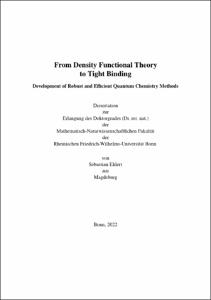From Density Functional Theory to Tight BindingDevelopment of Robust and Efficient Quantum Chemistry Methods

From Density Functional Theory to Tight Binding
Development of Robust and Efficient Quantum Chemistry Methods

| dc.contributor.advisor | Grimme, Stefan | |
| dc.contributor.author | Ehlert, Sebastian | |
| dc.date.accessioned | 2022-12-07T11:02:36Z | |
| dc.date.available | 2022-12-07T11:02:36Z | |
| dc.date.issued | 07.12.2022 | |
| dc.identifier.uri | https://hdl.handle.net/20.500.11811/10509 | |
| dc.description.abstract | The main topics of this thesis are efficient quantum chemical methods, their development, and the verification using existing and newly devised benchmark sets. The spectrum of quantum chemical methods discussed here includes wavefunction theory (WFT), (dispersion corrected) density functional theory (DFT), and semiempirical quantum mechanics (SQM), like density functional tight binding (DFTB) and extended tight binding (xTB). Special focus is set on the development and testing of dispersion corrected density functional theory to create widely applicable and robust methods for a broad range of chemical applications. Recent advances in modern density functional theory provide room for further improvements in combination with accurate dispersion corrections. For example, the latest generation of semi-classical D4 dispersion correction provides a more accurate model for describing long-range correlation effects compared to alternative methods. By extensively testing dispersion corrected density functionals, insights into the capabilities of the best available methods for computational chemistry can be obtained. With the general improvements available in density functional theory, the demand for more diverse and challenging benchmarks is increased to allow for meaningful comparisons between available methods. Especially, for non-covalent interactions obtaining accurate references is computationally demanding since the benchmarked energy differences are usually small. Large basis sets and converged numerical settings for correlated methods are needed to distinguish and rank well-performing methods. With the increasing capabilities of computers and computational chemistry, applications to larger systems and longer time scales become more important. This makes the development and advancement of approximate electronic structure methods another important aspect investigated here. The xTB Hamiltonian has recently emerged as a widely applicable solution for approximate quantum mechanical calculations, with a good cost–accuracy ratio in their geometry, frequency, and non-covalent interaction (GFN) parametrizations for target properties. In particular, the systematic extension of tight binding based SQM methods to a wider range of chemical applications in the condensed phase, like in solvation, is a topic discussed in this work. The wide range of investigated models provides important tools for computational simulations from exploratory work over large-scale screening to accurate thermochemistry calculations. Most importantly, the connection from accurate theory to approximate models is highlighted in several aspects of this work providing an integral view on the toolbox for theoretical modeling. | en |
| dc.language.iso | eng | |
| dc.rights | In Copyright | |
| dc.rights.uri | http://rightsstatements.org/vocab/InC/1.0/ | |
| dc.subject | Dichtefunktionaltheory | |
| dc.subject | Quantenchemie | |
| dc.subject | Theoretische Chemie | |
| dc.subject | Computerchemie | |
| dc.subject | Tight Binding | |
| dc.subject | London Dispersion | |
| dc.subject | Density functional theory | |
| dc.subject | quantum chemistry | |
| dc.subject | theoretical chemistry | |
| dc.subject | computational chemistry | |
| dc.subject.ddc | 540 Chemie | |
| dc.title | From Density Functional Theory to Tight Binding | |
| dc.title.alternative | Development of Robust and Efficient Quantum Chemistry Methods | |
| dc.type | Dissertation oder Habilitation | |
| dc.publisher.name | Universitäts- und Landesbibliothek Bonn | |
| dc.publisher.location | Bonn | |
| dc.rights.accessRights | openAccess | |
| dc.identifier.urn | https://nbn-resolving.org/urn:nbn:de:hbz:5-68903 | |
| dc.relation.doi | https://doi.org/10.1002/wcms.1493 | |
| dc.relation.doi | https://doi.org/10.1063/5.0041008 | |
| dc.relation.doi | https://doi.org/10.1021/acs.jpca.2c02439 | |
| dc.relation.doi | https://doi.org/10.1021/acs.jctc.1c00471 | |
| ulbbn.pubtype | Erstveröffentlichung | |
| ulbbnediss.affiliation.name | Rheinische Friedrich-Wilhelms-Universität Bonn | |
| ulbbnediss.affiliation.location | Bonn | |
| ulbbnediss.thesis.level | Dissertation | |
| ulbbnediss.dissID | 6890 | |
| ulbbnediss.date.accepted | 14.10.2022 | |
| ulbbnediss.institute | Mathematisch-Naturwissenschaftliche Fakultät : Fachgruppe Chemie / Institut für Physikalische und Theoretische Chemie | |
| ulbbnediss.fakultaet | Mathematisch-Naturwissenschaftliche Fakultät | |
| dc.contributor.coReferee | Bredow, Thomas | |
| ulbbnediss.contributor.orcid | https://orcid.org/0000-0001-7809-771X | |
| ulbbnediss.contributor.gnd | 1292280867 |
Dateien zu dieser Ressource
Das Dokument erscheint in:
-
E-Dissertationen (4466)




